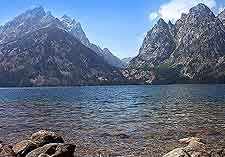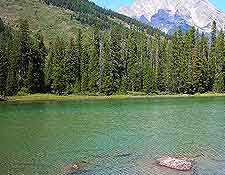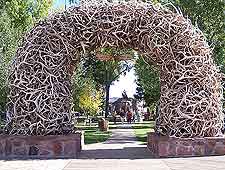Jackson Hole History Facts and Timeline
(Jackson Hole, Wyoming - WY, USA)

Avid skiers, cowboys and nature lovers in America all know the name of Jackson Hole well. This popular town, tucked into the Teton Range of Wyoming, is legendary for its ski resort, its vast cattle ranches and its amazing undeveloped wilderness.
Since the community's earliest days as a frontier outpost, the history of Jackson Hole hasn't strayed far from its original Western pioneer roots.
The Hole
Jackson 'Hole' got the last part of its name from the local vernacular used by mountain men and fur trappers to describe the sensation of entering a small valley ringed by towering mountains. They called it a 'hole', since to reach the valley they had to descend steep slopes and tight openings. The rest is Jackson Hole history, as they say. In fact, its official name is Jackson, while the greater valley area is known as Jackson Hole.

Trappers and Mountain Men
In the early 19th century, intrepid mountain men discovered the Teton Valley and its large population of beavers and other fur-bearing creatures. This was the height of the fur craze in Europe, so trappers were spreading across the American frontier in search of easy money.
David Edward Jackson is believed to have been one of the original mountain men who settled in the valley in 1829, and 'Jackson' Hole is named after him. The rugged, remote location of the valley deterred anyone from seriously establishing a town here until the latter part of the 1800s. But John Colter, a member of the Lewis and Clark Expedition, passed through the valley and recorded its beauty and resources in 1807.
Brief-lived Pioneer Town
As word spread of the region's untapped natural resources and wildlife, the first settlers began to set down roots to serve the itinerant trapper trade. This is when the history of Jackson Hole really begins. When fur fell out of fashion, the area returned to its natural state as a seasonal hunting ground for Native American tribes. Few whites stayed in the valley, which suffered brutal winters, as there was no economy left.
The World's First National Park
In 1871, the Hayden Expedition visited the Teton Valley and documented its natural beauty, with the first photographs taken of the area and nearby Yellowstone. The federal government in
Washington was so suitably impressed that it created the world's very first national park at Yellowstone. The establishment of the Grand Teton National Park to protect the mountains that surround Jackson Hole followed a few years later in 1929.

Cattle Ranchers
In the 1890s, the Teton Valley began attracting cattle ranchers. They arrived in such numbers that the town of Jackson Hole was officially laid out in 1894, and by 1900 it had streets and buildings as one would find in any small town. Some of the original structures and homes are still visible today around Town Square, in the center of Jackson.
A Modern Ski Town
The kinds of people who have always lived in the town and have shaped its history are outdoor lovers - from ranchers to hunters and fly fishermen. Jackson Hole gradually emerged in the 1900s as a place to enjoy untrammeled wilderness, recreation and wildlife. The Teton Mountains proved too tempting to ignore for skiers, and in 1937 a basic tow rope was set up at the Teton Pass for winter skiing.
From this early ski run came the Snow King Resort in 1939, the first of three major ski areas that currently exist around Jackson Hole. Today, this is a hugely popular four-season resort town. From summer hiking to winter skiing, tourism is presently what predominately drives the local economy.
 Avid skiers, cowboys and nature lovers in America all know the name of Jackson Hole well. This popular town, tucked into the Teton Range of Wyoming, is legendary for its ski resort, its vast cattle ranches and its amazing undeveloped wilderness.
Avid skiers, cowboys and nature lovers in America all know the name of Jackson Hole well. This popular town, tucked into the Teton Range of Wyoming, is legendary for its ski resort, its vast cattle ranches and its amazing undeveloped wilderness.
